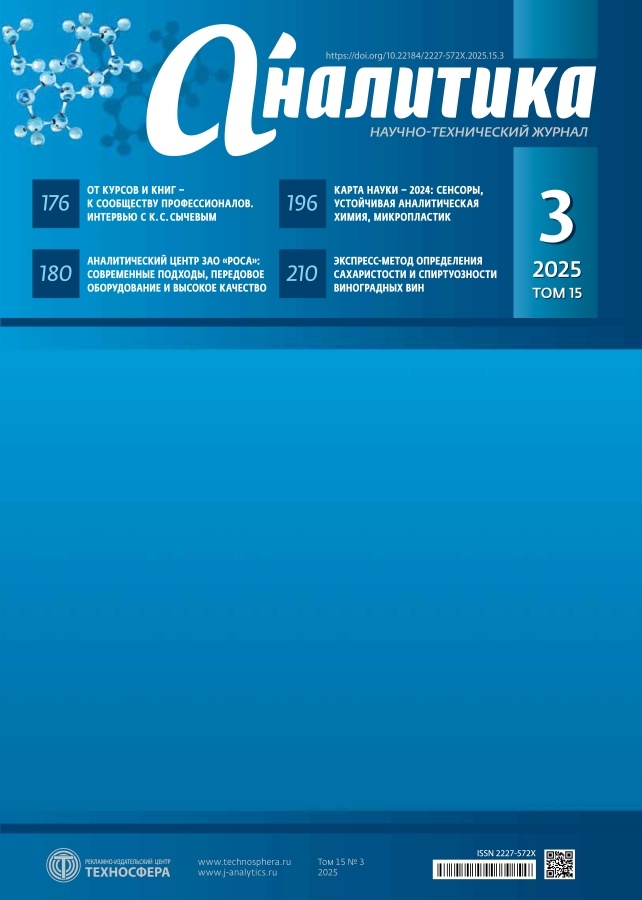Рефракто-денсиметрический метод определения сахаристости и спиртуозности вин, виноматериалов и крепленых напитков
- Авторы: Николаев В.Ф.1, Залальтдинов Ф.Ф.1, Гатауллин Ш.И.1, Минаева В.В.1
-
Учреждения:
- Казанский национальный исследовательский технологический университет
- Выпуск: Том 15, № 3 (2025)
- Страницы: 210-221
- Раздел: Аналитика веществ и материалов
- URL: https://journals.eco-vector.com/2227-572X/article/view/686827
- DOI: https://doi.org/10.22184/2227-572X.2025.15.3.210.221
- ID: 686827
Цитировать
Полный текст
Аннотация
Предложен экспресс-метод определения сахаристости и спиртуозности виноградных вин без предварительного отгона этилового спирта. Метод основан на измерении показателя преломления и плотности образца и использовании принципа аддитивности рефракто-денсиметрических характеристик смесей – интерцепта рефракции и удельной рефракции. При наличии встроенных в технологические емкости или продуктопроводы пар погружных или поточных рефрактометров и денсиметров метод может быть использован в производстве в режиме реального времени. Метод рассматривает вина как псевдотернарные смеси водных растворов сахаров (фруктоза: глюкоза 1 : 1 масс.), этанола и органических кислот (винная: яблочная 3 : 1 масс.). В последний компонент в неявном виде вносят вклад также другие минорные составляющие вин, близкие по рефракто-денсиметрическим характеристикам к кислотному реперу. Траектории процесса брожения сахарного и виноградного сусла показаны на хемографической карте Куртца – Лорентца. Упрощенный вариант метода рассматривает вина как бинарные смеси водных растворов сахаров и этилового спирта, в этом случае состав вин может быть определен графически по номограмме Куртца – Лорентца. Результаты измерений образцов вин показывают хорошее соответствие определенных показателей состава показателям, заявленным производителями.
Ключевые слова
Полный текст
Об авторах
Вячеслав Федорович Николаев
Казанский национальный исследовательский технологический университет
Автор, ответственный за переписку.
Email: NikolaevVF@corp.knrtu.ru
ORCID iD: 0000-0002-8742-8629
д. х. н., профессор
Россия, КазаньФилюс Фанисович Залальтдинов
Казанский национальный исследовательский технологический университет
Email: filus2022@yandex.ru
аспирант
Россия, КазаньШамиль Ильдусович Гатауллин
Казанский национальный исследовательский технологический университет
Email: journal@electronics.ru
бакалавр
Россия, КазаньВиктория Валерьевна Минаева
Казанский национальный исследовательский технологический университет
Email: journal@electronics.ru
бакалавр
Россия, КазаньСписок литературы
- Сompendium of international methods of wine and must analysis, vol. 1. Ed. 2023. International organisation of vine and wine. France: Printed in dijon 12, parvis de l’UNESCO 21000. Available from: https://www.oiv.int/sites/default/files/publication/2023-09/Compendium%20MA%20BOISPI%202023_EN%20.pdf
- Evangelou A., Kechagia D., Beris E et al. Correlation of Wine’s Main Components’ Concentration with the Density of Model Aqueous Solutions and Wine Samples. J. of Food Engineering and Technology. 2022; 11 (1):36–43. DOI.org/1032732/jfet.2022.11.1.36.
- Shehadeha A., Evangeloua A., Kechagiaa D. et al. Effect of ethanol, glycerol, glucose/fructose and tartaric acid on the refractive index of model aqueous solutions and wine samples. Food Chemistry. 2020; 329:127085. DOI.org/10.1016/j.foodchem.2020.127085.
- Gerogiannaki-Christopoluou M., Kyriakidis N. V., Atanasopoulos E. A. New Refractive Index Method for Measurement of Alcoholic Strength of Small Volume Samples. Journ.of AOAC International/. 2003; 86 (6):1232–5. doi: 10.1093/jaoac/86.6.1232.
- Иоффе Б. В. Рефрактометрические методы химии. – Л.: ГНТИХЛ, 1960. с. 384.
- Методы технохимического контроля в виноделии. Под ред. Гержиковой В. Г. 2-е изд. – Симферополь: Таврида, 2009. с. 304.
- Николаев В. Ф. Экспресс-метод определения сахаристости и спиртуозности виноградных вин и продуктов брожения сахаров с использованием хемографической карты Куртца – Лорентца. Препринт Preprint Researchgate, april 2024. doi: 10.13140/RG.2.2.33701.92641.
- Nikolaev V. F. Rapid Method for the Sugar- and Alcohol-Content Determination in Grape Wines and in Fermented Sugars Using the Kurtz-Lorentz Chemographic Map. Preprint SSRN. 2024; doi: 10.2139/ssrn.4901302.
- Николаев В. Ф. Экспресс-методы тестирования композиционных продуктов нефтепромысловой химии и моторных топлив. Казань: Изд-во КНИТУ. 2012. 124 с.
- Николаев В. Ф., Романова У. Г., Табрисов И. И. и др. Визуализация группового состава светлых нефтепродуктов и жидких продуктов органического синтеза. Вестн. Технол. ун-та. 2015; 18 (22): 43–46.
- Nikolaev V. F., Zalaltdinova N. D., Vyachkileva I. O. et al. Mapping technique for oil refining processes and products. Fuel. 2022; 307:121870. DOI.org/10.1016/j.fuel.2021.121870.
- Николаев В. Ф., Колоненкова О. О., Сулайман Ф. и др. Идентификационные карты Куртца – Лорентца в хемометрике водных растворов, органических жидкостей, жидких пищевых продуктов и биологических жидкостей: полярные координаты. Вестн. технол. ун-та. 2020; 23 (4): 81–86.
- Физическая химия. Теоретическое и практическое руководство. Учебн. пособ. Под ред. Никольского Б. П. 2-е изд. Л.: Химия, 1987. 880 с.
- Аристова Н. И., Зайцев Г. П., Панов Д. А. Определение основных органических кислот в различных типах вин после проведения технологических приемов. Ученые записки Крым. фед. ун-та им. В. И. Вернадского Сер. Биология. Химия. 2017; 3 (69):249–256.
- Partington, J. R. An Advanced. Treatise on Physical Chemistry. London; New York; Toronto: Published by Longmans, Green and Co. Ltd; 1953. vol .4, 700 p.
- Wolf A. V. Aqueous Solutions and Body Fluids. Hoeber Medical Division. New York: Harper & Row Publishers; 1966. 182 p.
- Kurtz S. S., Ward A. L. The Refractivity intercept and the specific refraction equation of Newton. I. Development of the refractivity intercept and comparison with specific refraction equations. Journal of the Franklin Institute.1936; 222 (5): 563–592.
- Kurtz S. S. The Chemistry of Petroleum Hydrocarbons. Edit by Brooks B. T., Boord C. E., Kurtz S. S., N.-Y: Schmerling L; 1954.
- Lange N. A., Sinks M. H. The solubility, specific gravity and index of refraction of aqueous solutions of fumaric, maleic and i-malic acids. J. Am. Chem. Soc. 1930; 52(7): 2602–2604.
- Государственная фармакопея 13 изд. т. 3 – М: Минздрав РФ, 2015.
- Баланов П. Е., Смотраева И. В. Лабораторный практикум по технологии вина – СПб: Университет ИТМО, 2019. 44 с.
- Авдеев Н. Я. Расчет гранулометрических характеристик полидисперсных систем. Ростов.-на-Дону госуд. пед. ун-т – Рост. книжн. изд-во, 1966. 54 с.
Дополнительные файлы













